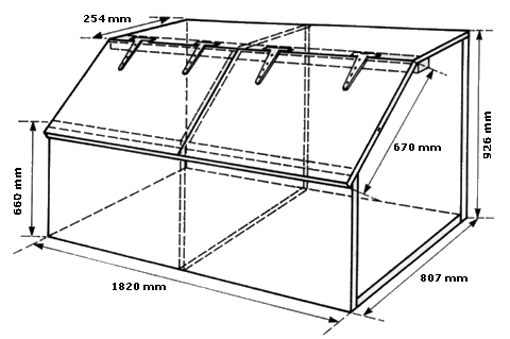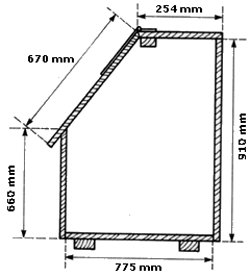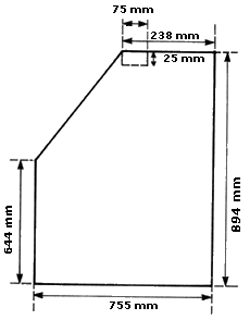
A bin for storing horse feeds
Series: Agfact A6.7.2 Edition: Second edition Last updated: 24 Jun 1999
Introduction
Close attention needs to be paid to the management of stables. The design and arrangement of facilities in the stables can have a big influence on stable management. Facilities which are well planned and well designed make horse care much easier and more enjoyable.
Feeding is one of the most important tasks around a stable. It can become a cumbersome chore if the facilities are not suitable. Storage bins for feed must be located in a convenient position and must have easy access for removing the feed and replenishing the bin when it is empty.
Bins must be vermin-proof and, at least, water-resistant. Mice and insects eat the feed and reduce its food value. Water will spoil the feed and make it unpalatable.
The amount of storage space needed will depend on the number of horses to be fed, their feed requirements, and how often the feed supply is to be replenished. It is useless having feed bins so small that they must be refilled every few days.
Design and use
The feed bin described here is suitable for two or three horses. It is made from wood and is vermin-proof. It is divided into two segments, each with its own lid. The angular design of the lid allows for greater access to the feed (see Figure 1).
Each segment of the bin will hold about 1½ to 2 bags of oaten chaff or about 200 kg of oats. These segments can easily be divided in half by adding another partition (Figure 3) in the centre. This will provide bins of a smaller capacity suitable for feeds, such as bran, which are not needed in large amounts. The length of the bin can be extended as needed, or a number of bins can be placed in the feed room.
Remember that each compartment should be emptied completely before being replenished. Any feed will become stale with time, and the feed at the bottom of the bin will become stale and unpalatable if the bin is not emptied regularly.
The bin does not need to be painted, but if this is done, lead-free paint must be used. Horses may suffer from lead poisoning if they are given enough feed that is contaminated with lead-based paint.
The bin can be placed flat on the floor of the feed room. However, if the floor is likely to become damp, the bin should be placed on two hardwood rails. This will increase its water resistance.
Diagrams of the bin, showing its dimensions, are shown in Figures 1 to 3. The materials and tools needed to build it are listed below.
Materials
- 16 mm particle board cut as follows:
- front—finished size 1820 mm × 660 mm
- back—finished size 1820 mm × 910 mm
- top—finished size 1820 mm × 254 mm
- bottom—finished size 1820 mm × 775 mm
- two ends and partition—finished size 775 mm × 894 mm
- two lids—finished size 910 mm × 670 mm
- three pieces of 75 mm × 25 mm hardwood, 1788 mm long
- four 2040 mm Tee hinges, and screws
- one packet (0.5 kg) of 50 mm × 2.8 mm nails
- one bottle of wood glue
Tools
- handsaw
- hammer
- screwdriver
- wood plane
- square
How to make the bin
Cut partitions and ends to size as shown in Figure 3. Cut out a piece 75 mm × 25 mm from the corner of the partition. This provides a seat for the length of hardwood.
Glue and nail the bottom to the partition and ends, then glue and nail the back and front to the partition and ends. One length of hardwood can then be glued and nailed in place. This will later provide the strength to hold in place the screws for the lid. Glue and nail the top in place, then use the four hinges to screw on the lids.
Figure 1. Total dimensions of feed bin (not to scale)

|
Figure 2. Cross-section of bin, showing lengths of sides, top, bottom and lid 
|
Figure 3. Size of ends and partition 
|

